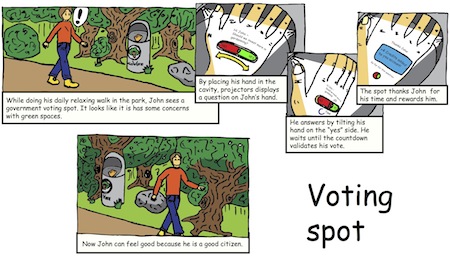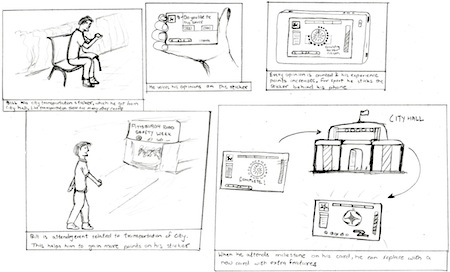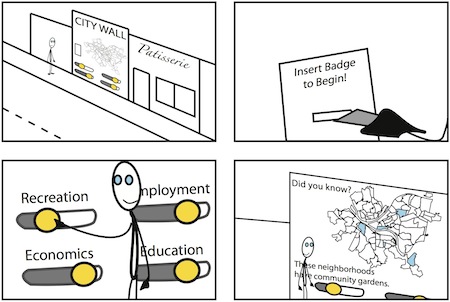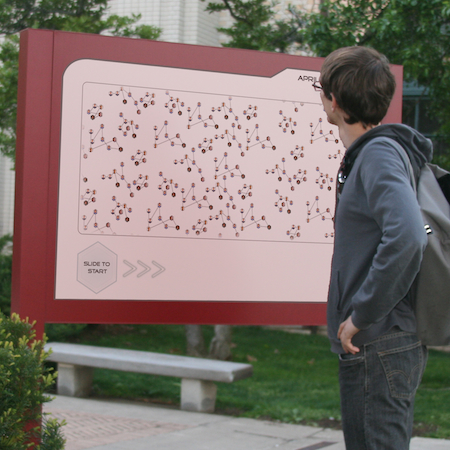Agora is a ubiquitous computing concept in which citizens can voice their ideas for and opinions about local government through large, interactive screens around a busy city.
Our team was tasked with exploring a social space in which citizens can express themselves and their thoughts about city government. Over six weeks, we researched and designed a concept, which we have dubbed Agora. Agora allows citizens to view the ideas of all their fellow citizens and connect their own ideas with them. Full details are below.
Team:
Julien Altieri, Rohan Gaikwad, and Kevin McMillin graduate students in human–computer interaction at Carnegie Mellon University.
Duration:
Six weeks
Skills used:
Field research, sketching, speed dating, video production
Background research
We began our research by visiting the Pittsburgh City–County Building, an imposing structure in which most of the officials in the City of Pittsburgh host their work. We were interested in observing how people in this building utilized its lobby space, a regal and largely empty area.
Later, we spoke with members of the City Council staff, who organize and arrange meetings and schedules for Pittsburgh's nine councilmembers. We also spoke with the Mayor's staff, who informed us that few people come to the building itself to voice their concerns, preferring instead more convenient solutions such as emailing or calling.

Research findings
Most visitors to City Hall are taking care of personal business
People rarely come to the City Hall building to propose a radical new idea or solution; most City Hall business is either official (filing permits, dealing with paperwork, registering wills) or internal (dealing with personnel, finances, and so on). Although people associate the building with municipal government, they probably won't start there if they have a new idea or opinion to share.
There are few methods for citizens to share opinions or the government to solicit feedback
Although the public's input is requested, often through the newspaper, on a number of matters, most City Hall business involving constituents is too intricate to involve random bystanders. Most input from constituents is currently reactionary—if the city proposes to a change that negatively affects some citizen, then he or she might be motivated to complain in person.
Current communication methods
Goals
Directly engage citizens
An effective city government needs effective input from its citizens. Our concept should actively encourage citizen engagement to ensure a broad range of interactions and ideas.
Allow citizens to be heard
Citizens need to feel like their voice is as important as someone else's in order to speak honestly and freely, and we feel as though the regal and official nature of the City Hall lobby can restrict this. Our concept should make citizens feel comfortable voicing their opinions.
Encourage a feeling of satisfaction
People are motivated to act when they can see the fruits of that interaction; however, citizens we spoke to characterized the government as generally very slow. Our concept should allows users to see what becomes of their previous interactions, so that they feel satisfied their voice was heard.
Give the government new opportunities for feedback
The government has a great opportunity to leverage a wider range of its constituency by reaching out beyond the 10 a.m. standing meeting in a physical location. Our concept should collect data and present it to policymakers in a meaningful way.
Preliminary sketches
Speed dating
We developed three scenarios to speed date with prospective users—a method in which we quickly present a sketched scenario and ask for feedback on it. For this project, we conducted speed dating sessions with 12 users, many of whom may have been biased because they are actively studying human–computer interaction. After refining our scenarios, we conducted additional speed dating with three more users.
First scenario
In our first scenario, the city would augment public places with physical "Voting Spots," in which citizens can approach and answer simple questions posed by the city government using a novel gestural interaction technique. We received positive feedback on this idea, although our users felt uncomfortable by the notion of "voting" in what appeared to be a public place. What if the questions were quite personal?

Second scenario
Our second scenario, City Sticker, introduces the idea of an interactive sticker through which the city can ask targeted questions of its citizens. For instance, in the scenario presented here, Bill has a city transportation sticker, and the city asks him a question about bus services. Answering more questions and attending city events allows you to gain more points on your sticker, which can be leveled-up at City Hall. Our users liked this idea a lot, but they questioned why it wasn't just a mobile application. They found it handy, but they also wondered what their motivation for contributing was. They also wondered how their opinions would be used.

Third scenario

Final concept design
Our final concept is Agora. It allows citizens to submit ideas about city government via video, audio, or text using an interactive screen. These interactive screens are displayed all around the city, so that even those who live far from City Hall could still have their voice heard.
From afar, citizens are shown a gently moving sea of ideas—a mind map of connections created by their fellow citizens. They can pan around, scale, move, and expand these ideas. If they'd like to create an idea of their own, or to leave a comment on an existing idea, they can slide a hexagon in the lower-left corner to start participating.
As citizens describe their idea, the screen begins to dynamically filter and organize ideas that it thinks are related. Citizens are then invited to draw explicit connections to those related ideas. The interaction finishes by printing a custom sticker symbolizing this experience for the citizen. Later, citizens can check the status of their ideas and opinions by authenticating themselves with the sticker they were given.

Video sketch
To finalize our concept, we created this two-minute video sketch showing parts of its interaction. We used Adobe Illustrator, Adobe Premiere, Adobe Audition, and Adobe After Effects to produce this video.